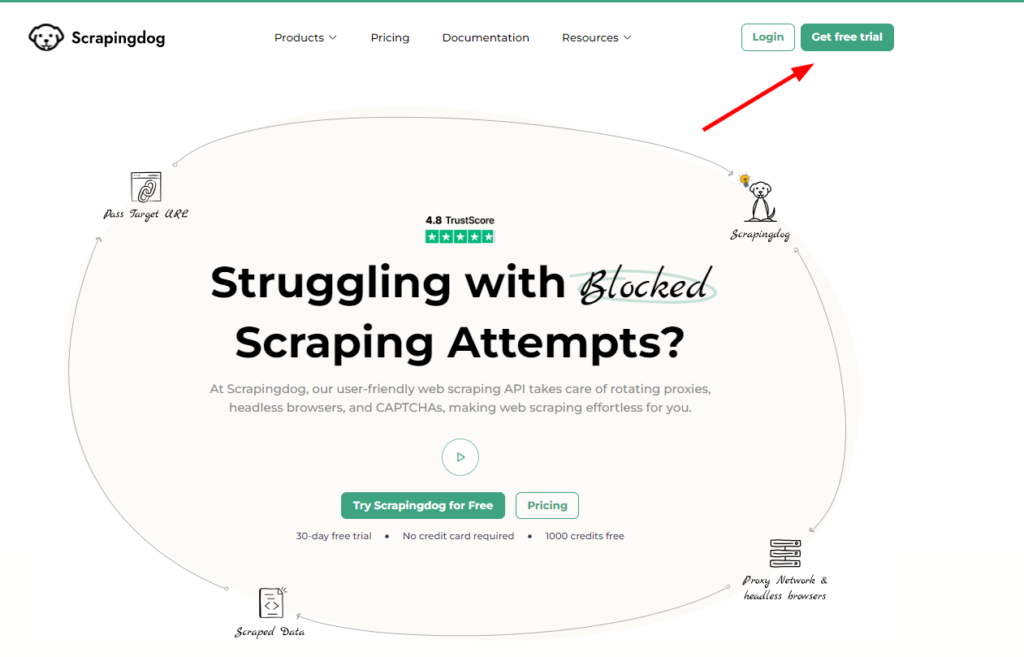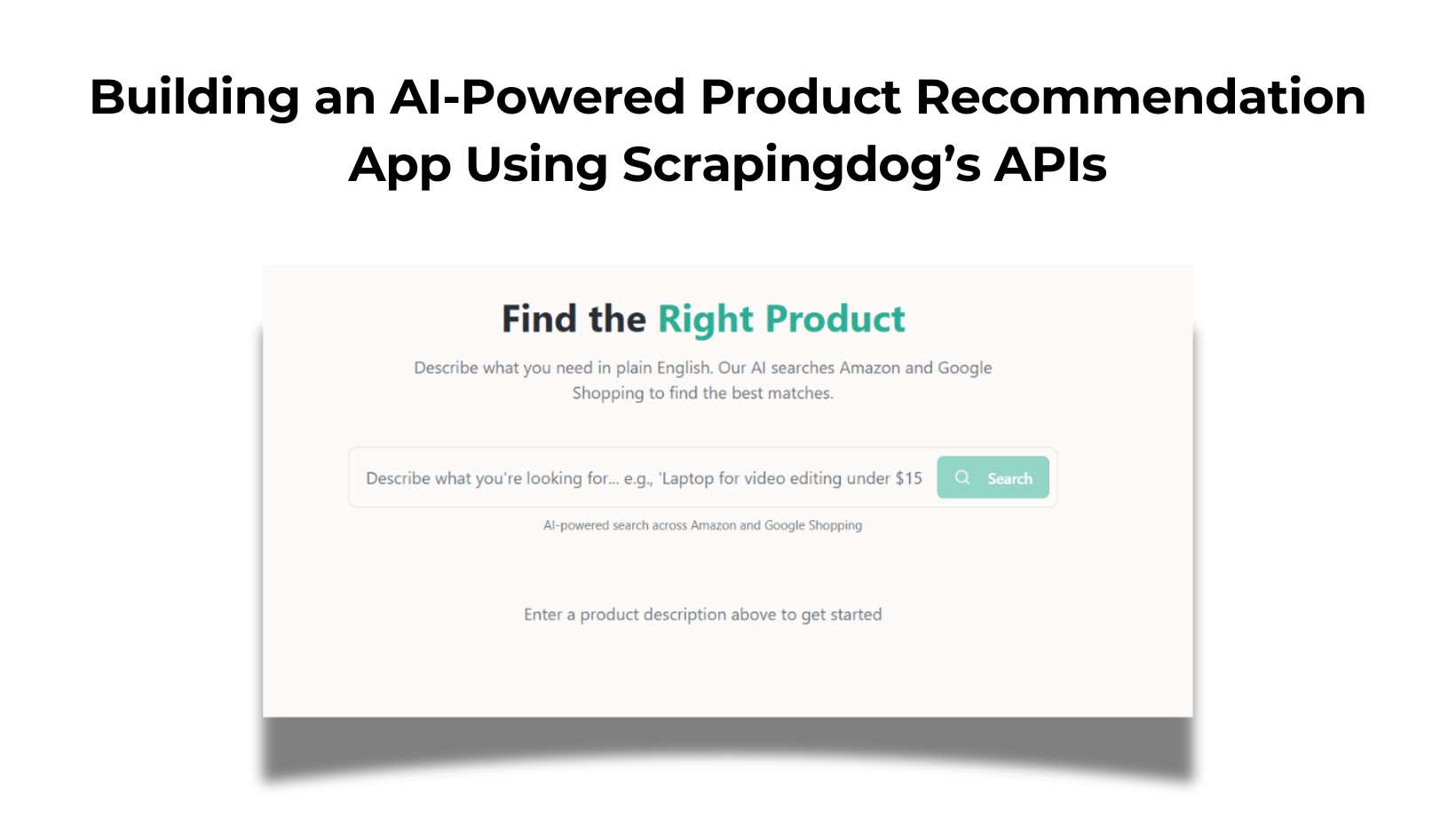TL;DR
- Build a Python scraper to extract TikTok profile data (username, avatar, followers/following, bio, website).
- Use Scrapingdog to fetch dynamic HTML (free 1,000-credit trial), then parse with
BeautifulSoup. - Store records with
pandastotiktok.csv(sample output shown). - Scrapingdog handles proxies, CAPTCHAs, and headers so TikTok scraping stays reliable.
Scraping TikTok data can unlock powerful insights, from tracking viral trends to analyzing influencer reach and engagement. Whether you’re a marketer trying to identify the next big influencer, a brand looking to track trends, or a researcher analyzing user engagement, extracting data from TikTok can provide powerful insights.
In this blog, I’ll show you how to scrape real-time insights from TikTok using Python.
What will you learn?
In this guide, we will use various tools to extract data from TikTok. But before we begin, let me just give you an overview of what you will learn in this article.
- Basic Python scraper setup with proper library installation.
- Scraping TikTok with a Web Scraping API.
- We’ll be scraping key profile attributes such as follower count, following count, profile picture URL, and bio information.
- Store data in a CSV file.
If you’re new to web scraping, I highly recommend reading Web Scraping with Python to gain valuable insights. This guide will help you build a solid foundation, making it easy to scrape data from virtually any website.
Requirements
I hope you have already installed Python on your computer; if not, then you can install it from here. Now, create a folder in which we will keep the project files.
mkdir tiktok
Install three libraries inside this folder.
requestsfor making an HTTP connection with the target website.BeautifulSoupfor parsing the raw data.Pandasfor storing data in a CSV file.
pip install requests
pip install beautifulsoup4
pip install pandas
Now, sign up for the free trial pack. The trial pack includes 1000 credits, which are enough to build a small scraper.

Finally, create a Python file in which we will code our TikTok scraper. I am naming this file as social.py.
Scraping TikTok with Python
Let’s first decide what exactly we want to scrape from TikTok

- Profile picture
- Username
- Number of followers
- Number of following Accounts
- Website link.
- Bio.
Analyzing the HTML structure of the page

Profile picture is located inside the img tag with class css-1zpj2q-ImgAvatar.

The username is located inside the h1 tag.

The number of followers is located inside the strong tag with the attribute title and value Followers.

Similarly, the following count is located inside the strong tag with attribute title and value Following.

Bio is located inside an h2 tag with attribute data-e2e and value user-bio.

The website link is located inside an a tag with an attribute data-e2e and value user-link.
| Profile | img tag with class css-1zpj2q-ImgAvatar. |
| Username | h1 tag |
| Followers | strong tag with the attribute title and value Followers |
| Following | strong tag with attribute title and value Following |
| Bio | h2 tag with attribute data‑e2e and value user‑bio |
| Website | a tag with an attribute data‑e2e and value user‑link |
We have the location of each element. Now, we can code and extract this data.
Download data from TikTok
Before we start coding, I recommend reading the documentation of Scrapingdog.
import requests
from bs4 import BeautifulSoup
params={
'api_key': 'your-api-key',
'url': 'https://www.tiktok.com/@kimkardashian?lang=en',
'dynamic': 'true',
'wait': '3000',
}
response = requests.get("https://api.scrapingdog.com/scrape", params=params)
print("status code is ",response.status_code)
print(response.text)
The code is straightforward, but let me explain you step by step.
- First, we have imported the libraries that we installed earlier.
- Then, we created a
paramsobject containing the necessary parameters required to make a request to the Scrapingdog Web Scraping API. - Using requests, we made a GET request to the API.
- Finally, we are printing the status of the request and the downloaded data.
Once we run this code, you will get this on your console.

As you can see, we got a 200 status code. Now, we can proceed ahead and parse the data using BS4.
Parsing data from TikTok using BeautifulSoup
soup = BeautifulSoup(response.text, 'html.parser')
try:
obj["username"]=soup.find("h1").text
except:
obj["username"]=None
try:
obj["profile"]=soup.find("img",{"class":"css-1zpj2q-ImgAvatar"}).get('src')
except:
obj["profile"]=None
try:
obj["following"]=soup.find("strong",{"title":'Following'}).text
except:
obj["following"]=None
try:
obj["followers"]=soup.find("strong",{"title":'Followers'}).text
except:
obj["followers"]=None
try:
obj["Bio"]=soup.find("h2",{"data-e2e":'user-bio'}).text
except:
obj["Bio"]=None
try:
obj["website"]=soup.find("a",{"data-e2e":"user-link"}).get('href')
except:
obj["website"]=None
l.append(obj)
print(l)
Here using the find() function of BeautifulSoup I have extracted the text value of each element. Once you run the code you should see this data on your console.
[{'username': 'kimkardashian',
'profile': 'https://p19-pu-sign-useast8.tiktokcdn-us.com/tos-useast5-avt-0068-tx/7310049872432857130~tplv-tiktokx-cropcenter:1080:1080.jpeg?dr=9640&refresh_token=bad80b71&x-expires=1745485200&x-signature=C2YQZ3vduWrLxGgZ%2BaG%2FkwvZ3O4%3D&t=4d5b0474&ps=13740610&shp=a5d48078&shcp=81f88b70&idc=useast5',
'following': '15',
'followers': '9.9M',
'Bio': 'No bio yet.',
'website': 'https://www.tiktok.com/link/v2?aid=1988&lang=en&scene=bio_url&target=skims.social%2Fkim_sale_tiktok'
}]
As you can see, we are successfully able to scrape & parse all the data from TikTok with the help of Scrapingdog and Python.
Saving data to a CSV file
For this part, we will need the help of the pandas library.
df = pd.DataFrame(l)
df.to_csv('tiktok.csv', index=False, encoding='utf-8')
After running the code, you will get a tiktok.csv file inside your folder.

Complete Code
We can scrape video stats too from TikTok for any particular video, I will leave this exercise to you. But for the current scenario, the code will look like this.
import requests
from bs4 import BeautifulSoup
import pandas as pd
l=[]
obj={}
params={
'api_key': 'your-api-key',
'url': 'https://www.tiktok.com/@kimkardashian?lang=en',
'dynamic': 'true',
'wait': '10000',
}
response = requests.get("https://api.scrapingdog.com/scrape", params=params)
print("status code is ",response.status_code)
soup = BeautifulSoup(response.text, 'html.parser')
try:
obj["username"]=soup.find("h1").text
except:
obj["username"]=None
try:
obj["profile"]=soup.find("img",{"class":"css-1zpj2q-ImgAvatar"}).get('src')
except:
obj["profile"]=None
try:
obj["following"]=soup.find("strong",{"title":'Following'}).text
except:
obj["following"]=None
try:
obj["followers"]=soup.find("strong",{"title":'Followers'}).text
except:
obj["followers"]=None
try:
obj["Bio"]=soup.find("h2",{"data-e2e":'user-bio'}).text
except:
obj["Bio"]=None
try:
obj["website"]=soup.find("a",{"data-e2e":"user-link"}).get('href')
except:
obj["website"]=None
l.append(obj)
print(l)
df = pd.DataFrame(l)
df.to_csv('tiktok.csv', index=False, encoding='utf-8')
Conclusion
Scraping TikTok data can be a valuable asset for market research, trend analysis, or even content strategy. However, due to TikTok’s strict anti-bot measures, scraping it directly can be quite challenging. That’s where Scrapingdog steps in, it simplifies the process by handling all the heavy lifting, like proxy rotation, CAPTCHA solving, and headers management.
It also utilizes static residential proxies to ensure more consistent access and reduce the chances of detection or blocking.
Using Python, you’ve seen how easy it is to integrate Scrapingdog’s Web Scraping API to extract TikTok data efficiently without hitting constant roadblocks. Whether you’re tracking influencers, analyzing engagement, or pulling video metadata, this approach ensures reliability and scalability.


